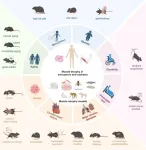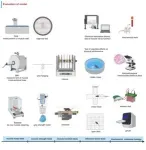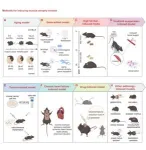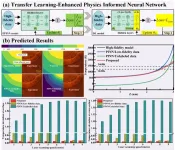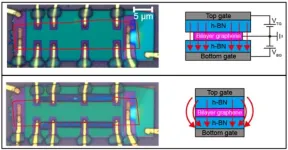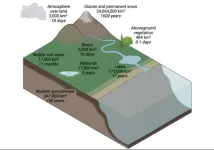(Press-News.org) With the intensification of global population aging, muscle atrophy, characterized by the loss of muscle mass and function, has become an important health issue affecting the elderly. Researchers have widely used various animal and cellular models to gain a deeper understanding of the pathophysiological mechanisms of muscle atrophy and develop effective treatment strategies (Figure 1). These models simulate human muscle atrophy through different induction methods, such as natural aging, gene editing, nutritional changes, physical activity, chronic wasting diseases, and drug treatments. Common experimental animals include mice, rats, fruit flies, nematodes, and zebrafish, while cellular models are used for more detailed molecular mechanism studies. Various methods have been developed to evaluate muscle atrophy models (Figure 2).
1. Animal models (Figure 3)
1.1 Natural aging model
Application: The natural aging model is one of the most commonly used muscle atrophy models, especially for studying sarcopenia. This model observes the natural muscle changes that occur with age in animals, accurately reflecting the physiological changes in muscle atrophy during human aging.
Limitations: It takes a long time to observe significant muscle atrophy, resulting in extended experimental periods and high costs. Additionally, individual differences can lead to inconsistent results.
1.2 Gene editing model
Application: gene editing technology can be used to create specific gene mutation mouse models, simulating muscle atrophy caused by accelerated aging or specific genetic defects. These models help study the role of genes in muscle atrophy.
Limitations: Constructing complex gene-edited models requires significant technical and time investment, and some gene mutations may not fully replicate the true nature of human diseases.
1.3 Nutritional intervention model
Application: High-fat diet (HFD) induced models are used to study the effects of obesity and related metabolic disorders on muscles. Feeding animals a high-fat diet rapidly induces metabolic syndrome, leading to muscle atrophy. This model is suitable for studying muscle atrophy associated with obesity, insulin resistance, and type 2 diabetes.
Limitations: HFD can cause other complications, such as cardiovascular disease and liver damage, which may interfere with experimental results. Long-term HFD can also alter animal behavior, increasing the complexity of experimental variables.
1.4 Physical activity restriction model
Application: Restricting physical activity (e.g., immobilizing limbs or reducing living space) can rapidly induce muscle atrophy, making it suitable for short-term experiments and preliminary screening of drugs or treatments.
Limitations: Physical activity restriction does not fully simulate the natural process of muscle atrophy and may induce stress responses, affecting experimental outcomes.
1.5 Disease-induced model
Application: Inducing chronic wasting diseases (e.g., cancer, heart failure) can simulate the process of cachexia and study the impact of systemic inflammation and metabolic imbalance on muscles.
Limitations: Different diseases have complex and diverse pathogenic mechanisms, making it difficult to find a single model that represents all conditions; inducing diseases also poses technical challenges.
2. Cellular models (Figure 4)
Application: Culturing myotubes or myoblasts in vitro allows for detailed study of molecular mechanisms within muscle cells, such as protein synthesis and degradation, and signal transduction pathways. These models are suitable for high-throughput drug screening and mechanistic studies.
Limitations: In vitro environments differ significantly from in vivo conditions, and cell behavior in culture dishes may not accurately reflect in vivo scenarios. The lack of complex tissue structures and microenvironments limits their ability to fully simulate real muscle function.
3. Small organism models
Application: Using organisms like fruit flies, nematodes, and zebrafish to establish muscle atrophy models offers advantages such as rapid reproduction, low cost, and ease of manipulation, making them suitable for large-scale screening and initial hypothesis testing.
Limitations: These organisms differ significantly from mammals in terms of physiological structure and metabolic pathways, requiring cautious interpretation when applying results to humans.
To better understand and manage muscle atrophy, researchers are continuously improving existing models and exploring new modeling methods. By comprehensively evaluating the strengths and weaknesses of different models, scientists aim to identify the most appropriate tools for specific research objectives. These efforts are crucial for advancing the study of muscle atrophy mechanisms and developing effective treatments (Figure 5).Integrating AI and multi-omics approaches will further refine these models, potentially leading to better preventive and therapeutic strategies for patients. Studying muscle atrophy models plays a vital role in promoting healthy aging and reducing the disabilities and dependence associated with sarcopenia and cachexia.
This study was co-supervised by Associate Professor Chenyin Fu and Professor Birong Dong (Geriatric Health Care and Medical Research Center, National Clinical Research Center for Geriatrics, West China Hospital, Sichuan University). Gongchang Zhang and Fengjuan Hu reviewed the applications, limitations, and future prospects of muscle atrophy models.
See the article: The recent development, application, and future prospects of muscle atrophy animal models
https://doi.org/10.1002/mef2.70008
END
Applications, limitations, and prospects of different muscle atrophy models in sarcopenia and cachexia research
2025-01-10
ELSE PRESS RELEASES FROM THIS DATE:
FIFAWC: A dataset with detailed annotation and rich semantics for group activity recognition
2025-01-10
Group Activity Recognition (GAR), which aims to identify activities performed collectively in videos, has gained significant attention recently. Existing GAR datasets typically annotate only a single Group Activity (GA) instance per sample, carefully selected from original videos. This approach, while precise, diverges significantly from real-world contexts, which often involve multiple GA instances. Moreover, single word-level annotations are insufficient to encapsulate the complex semantic information in GA, thereby constraining the expansion and ...
Transfer learning-enhanced physics-informed neural network (TLE-PINN): A breakthrough in melt pool prediction for laser melting
2025-01-10
Researchers have developed a transfer learning-enhanced physics-informed neural network (TLE-PINN) for predicting melt pool morphology in selective laser melting (SLM). This novel approach combines physics-informed constraints with deep learning techniques, achieving superior accuracy, faster training times, and reduced computational demands. Published in Advanced Manufacturing, this breakthrough has significant potential to improve the efficiency of SLM processes, enable intelligent real-time process control, and enhance manufacturing quality.
Selective Laser Melting ...
Holistic integrative medicine declaration
2025-01-10
In the quest to address contemporary health challenges and advance medical science, the concept of Holistic Integrative Medicine (HIM) emerges as a pivotal approach. This paradigm emphasizes the integration of medical knowledge and practices, advocating for a shift from traditional, fragmented medical models to a more comprehensive and human-centered system. HIM represents a conscious evolution in medical thought, aiming to align with the holistic needs of patients and the complex dynamics of health and disease. It underscores the importance of dimensionality reduction and differentiation as ...
Hidden transport pathways in graphene confirmed, paving the way for next-generation device innovation
2025-01-10
Electron transport in bilayer graphene exhibits a pronounced dependence on edge states and a nonlocal transport mechanism, according to a recent study led by Professor Gil-Ho Lee and Ph.D. candidate Hyeon-Woo Jeong of POSTECH’s Department of Physics, in collaboration with Dr. Kenji Watanabe and Dr. Takashi Taniguchi at Japan’s National Institute for Materials Science (NIMS). The findings were published in the international nanotechnology journal Nano Letters.
Bilayer graphene, comprising two vertically stacked graphene layers, can exploit externally applied electric fields ...
New Neurology® Open Access journal announced
2025-01-10
MINNEAPOLIS – The American Academy of Neurology announces today its newest journal, Neurology® Open Access, which joins the flagship journal Neurology® and its four subspecialty journals. The new online peer-reviewed journal publishes original research articles, scholarly reviews, case reports and study protocols in all areas of neurology and the clinical neurosciences.
Editor-in-Chief of Neurology® José G. Merino, MD, MPhil, FAAN, FAHA, said, “The new journal complements the lineup of the Neurology® ...
Gaza: 64,000 deaths due to violence between October 2023 and June 2024, analysis suggests
2025-01-10
An independent study by researchers from the London School of Hygiene & Tropical Medicine (LSHTM) suggests the Palestinian Ministry of Health in Gaza underreported the death toll due to violence by approximately 41%.
The LSHTM study estimated 64,260 traumatic injury deaths in Gaza between 7 October 2023 and 30 June 2024 compared to the 37,877 reported by the Palestinian Ministry of Health.
The findings, published in The Lancet, indicate that approximately 3% of the population of Gaza has died due to violence with an analysis showing ...
Study by Sylvester, collaborators highlights global trends in risk factors linked to lung cancer deaths
2025-01-10
MIAMI, FLORIDA (EMBARGOED UNTIL JAN. 9, 2025 AT 6:30 P.M. EST) – Even though lung and related cancer deaths decreased in the world’s 10 most populous countries from 1990 to 2019, these positive statistics do not address trends in mortality linked to tobacco use, air pollution and asbestos exposure. Those areas need ongoing policy measures and research to further reduce deaths, according to a new study from researchers at Sylvester Comprehensive Cancer Center, part of the University of Miami Miller School of Medicine, and collaborating organizations.
Their study, published in eClinicalMedicine, ...
Oil extraction might have triggered small earthquakes in Surrey
2025-01-10
A series of more than 100 small earthquakes in Surrey in 2018 and 2019 might have been triggered by oil extraction from a nearby well, suggests a new study by UCL researchers.
The earthquakes, which occurred in Newdigate and surrounding areas from April 2018 until early 2019, were recorded as being between 1.34 and 3.18 magnitude, and were linked to cracks in walls and ceilings and other damage to people’s homes, with reports of houses and beds shaking.
Geologists have been divided over whether these earthquakes could have been triggered by extraction at the Horse Hill well in Horley about 5km ...
Launch of world’s most significant protein study set to usher in new understanding for medicine
2025-01-10
Launch of world’s most significant protein study set to usher in new understanding for medicine
Strict embargo: 00.01 (GMT), Friday 10 January 2025
UK Biobank has today announced the launch of the world’s most comprehensive study of the proteins circulating in our bodies, which will transform the study of diseases and their treatments. This unparalleled project aspires to measure up to 5,400 proteins in each of 600,000 samples, including those taken from half a million UK Biobank participants and 100,000 second samples taken from these volunteers up to 15 years later. This will ...
New study from Chapman University reveals rapid return of water from ground to atmosphere through plants
2025-01-09
Orange, California - January 9, 2025: A new study led by scientists in the Schmid College of Science and Technology at Chapman University provides the first comprehensive global estimates of the amount of water stored in Earth’s plants and the amount of time it takes for that water to flow through them. The information is a missing piece of the puzzle in understanding the global water cycle and how that cycle is being altered by changes in land use and climate.
The study, published today, January 9, in the journal ...
